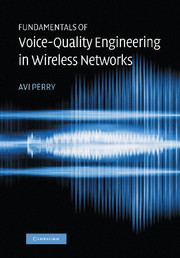Book contents
- Frontmatter
- Contents
- Preface
- List of abbreviations
- Introduction
- Part I Voice-quality foundations
- Part II Applications
- Part III Wireless architectures
- Part IV A network operator's guide for selecting, appraising, and testing a VQS
- 9 A network operator's guide to testing and appraising voice-quality systems
- 10 Service provider's system, management, and delivery requirements
- 11 Making economically sound investment decisions concerning voice-quality systems
- Part V Managing the network
- Part VI Afterthoughts and some fresh ideas
- Part VII Recordings
- Glossary of common voice-quality systems terminology
- Brief summary of echo cancelation and VQS major standards
- Brief summary of key voice-quality assessment standards
- Bibliography
- Index
11 - Making economically sound investment decisions concerning voice-quality systems
Published online by Cambridge University Press: 24 May 2010
- Frontmatter
- Contents
- Preface
- List of abbreviations
- Introduction
- Part I Voice-quality foundations
- Part II Applications
- Part III Wireless architectures
- Part IV A network operator's guide for selecting, appraising, and testing a VQS
- 9 A network operator's guide to testing and appraising voice-quality systems
- 10 Service provider's system, management, and delivery requirements
- 11 Making economically sound investment decisions concerning voice-quality systems
- Part V Managing the network
- Part VI Afterthoughts and some fresh ideas
- Part VII Recordings
- Glossary of common voice-quality systems terminology
- Brief summary of echo cancelation and VQS major standards
- Brief summary of key voice-quality assessment standards
- Bibliography
- Index
Summary
Introduction
Chapter 11 discusses key differences between stand-alone and integrated systems. It points to the pros and cons of investing in a full VQS suite versus a minimal set containing a hybrid-echo canceler only, and it closes with a simple model providing guidelines for assessing return on investment.
In recent years, stand-alone voice-quality systems have been losing share to voice-quality and echo-canceler modules that have been integrated within mobile-switching centers (MSCs) even though some of these integrated systems have demonstrated poorer performance, and most have not included voice-quality applications beyond echo cancelation. Still, there have been pockets of trend-defying markets that continue to pursue stand-alones, and some companies have even installed them in place of existing integrated systems.
This chapter brings to light business considerations associated with investment decisions by service providers who look for return on their investment in VQS. An important step in the determination process is whether the VQS is to include functionality in addition to hybrid-echo cancelation, and whether that functionality is to be delivered via a stand-alone or an integrated system.
Accordingly, the first part of the chapter contrasts the merits and drawbacks of using stand-alone versus integrated systems. It describes the various trade-offs that must be considered during the process of determining which configuration (stand-alone versus integrated) is best suited for a specific application. The analysis involves considering state of the art performance and feature richness, cost, network growth, operations, and codec implementations.
- Type
- Chapter
- Information
- Fundamentals of Voice-Quality Engineering in Wireless Networks , pp. 249 - 258Publisher: Cambridge University PressPrint publication year: 2006



